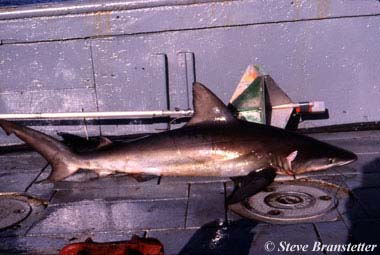
Carcharhinus altimus
This plain grey shark has a broad, bluntly pointed snout with prominent nostril flaps, hence its name. It mostly lives off shore, eating bony fish and other elasmobranch (smaller sharks and rays) from near the sea floor. Because of its deep water habitat, it is considered a low-risk shark to humans.
Order – Carcharhiniformes
Family – Carcharhinidae
Genus – Carcharhinus
Species – altimus
Common Names
English language common names include bignose shark and Knopp’s shark. Other names used to refer to this species are baboso (Spanish), grootneushaai (Afrikaans), grootsnuithaai (Dutch), karcharinos megalorynchos (Greek), marracho baboso (Portuguese), requin babosse (French), squalo naso grande (Italian), tiburón baboso (Spanish), tiburón narizón (Spanish), and tubarão-baboso (Portuguese).
Importance to Humans
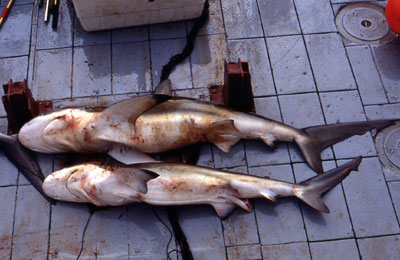
The bignose shark is caught by offshore trawlers and rarely by hook and line. It is harvested in the Caribbean region with deep longlines and is utilized for fish meal for animal feed, and for oil. In U.S. waters, this species is currently prohibited from capture in the commercial shark fishery.
Danger to Humans
Although this shark is large, it poses little threat to humans due to its deepwater habitat.
Conservation
> Check the status of the bignose shark at the IUCN website.
The IUCN is a global union of states, governmental agencies, and non-governmental organizations in a partnership that assesses the conservation status of species.
The longline bignose shark fishery is managed and regulated by the National Marine Fisheries Service off the coast of the U.S. At this time, bignose sharks are prohibited from harvest in U.S. waters. If this species is caught, it must be released immediately into the water in a manner that maximizes the shark’s survival.
Geographical Distribution
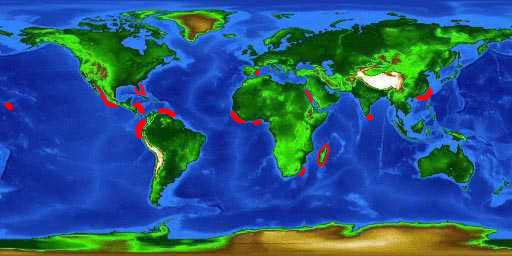
Bignose sharks are circumglobal in distribution with records in tropical and warm regions. In the western Atlantic Ocean, it occurs from Florida (USA) south to Venezuela while in the eastern Atlantic Ocean it has been reported from Senegal to Ghana including the Mediterranean Sea. Reports from the western Indian Ocean include the Red Sea, Mozambique, South Africa, Madagascar, and India. Distribution in the Pacific Ocean is off China in the west, Hawaii in the central, and Gulf of California, Mexico, Colombia, and Ecuador in the east.
Habitat
This large offshore species is found near the edges of continental shelves and insular slopes at depths from near the surface to 1,410 feet (430 m). The adults often swim at depths greater than 295 feet (90 m) while the juveniles frequent shallower waters.
Distinguishing Characteristics
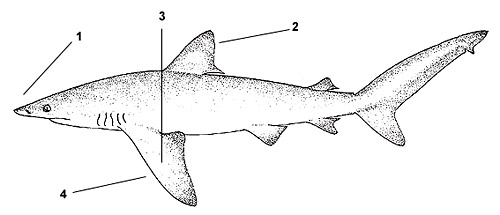
1. Snout long and bluntly pointed to rounded
2. First dorsal fin large
3. First dorsal fin originates over pectoral fin insertion to midlength of pectoral fin inner margin
4. Pectoral fins long, nearly straight
Biology
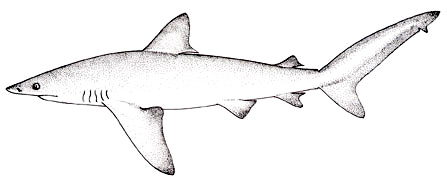
Distinctive Features
The bignose shark is large and slender with a long, broad and bluntly pointed snout from which it gets its common name. The well developed nasal flaps are prominent. The interdorsal ridge is high and conspicuous. The pectoral fins are long and straight. The first dorsal fin has a bluntly pointed apex with an origin above or posterior to the axils of the pectoral fins. The origin of the anal fin is slightly behind that of the second dorsal fin.
Bignose sharks are similar to night sharks (C. signatus) in appearance, however night sharks have a second dorsal fin free rear tip that is at least twice as long as the second dorsal fin height while the bignose shark does not have a long second dorsal fin free rear tip. C. signatus also has green eyes.
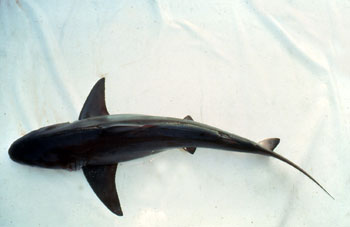
Coloration
Grayish body with no prominent markings other than being white below and having black tips inner corners of the pectoral fins. The tips of all fins other than the pelvics are dusky in color. There may be a green sheen along the gills of freshly collected specimens.
Dentition
Teeth located in the upper jaw are large and broadly triangular with serrated edges except for the first two series at each side of symphysis which have concave lateral margins, straight to convex medial margins, and both margins are serrated. There is one or two small symphysial teeth. Lower teeth are narrow with finely serrated margins, narrow serrated cusps, and one symphysial tooth.There are 14-16 teeth on each side of the upper jaw (not counting the symphysial teeth) and 14 or 15 in the lower jaw.
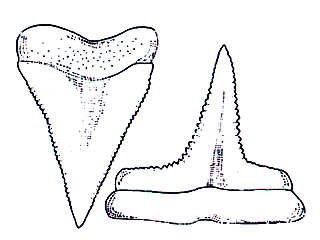
Size, Age, and Growth
Bignose sharks may reach lengths to 9.8 feet (3 m) TL and weights of 370 pounds (167.8 kg). At birth, bignose pups are between 2 to 3 feet (70 to 90 cm) in length. Males reach maturity at 7.1 feet (216-217 cm) in length and females at 7.4-9.3 feet (226-282 cm).
Food Habits
Prey of this offshore shark consists of bony fishes including mackerels, soles, and batfish; and other elasmobranchs including dogfish, catsharks,and stingrays; and cephalopods.
Reproduction
Reproductive mode is viviparous with yolksac placentas. Birth occurs during different times of the year depending upon location, in the Mediterranean this is from August to September while off Madagascar birth occurs during September and October. Litter size ranges from 3-11 pups approximately 2.3-3.0 feet (70-90 cm) in length.

Predators
Other sharks are potential predators on juvenile bignose sharks.
Taxonomy
The bignose shark was described in 1950 as Carcharhinus altimus by Stewart Springer. This specimen used in the description was caught in the Florida Keys. The genus name Carcharhinus is derived from the Greek “karcharos” = sharpen and “rhinos” = nose. Synonyms include Carcharhinus radamae Fourmanoir 1961 and Carcharinus radamaeFourmanoir 1961.
Prepared by: Cathleen Bester